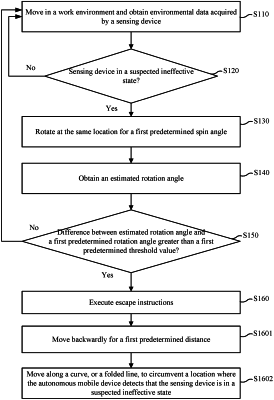| CPC G05D 1/027 (2013.01) [G05D 1/0212 (2013.01); G05D 1/0246 (2013.01); G06T 5/70 (2024.01)] | 16 Claims |

|
1. A method executable by an autonomous mobile device, comprising:
moving in a work environment;
obtaining environmental data acquired by a sensing device;
determining whether the sensing device is in a suspected ineffective state based on the environmental data, the suspected ineffective state being a state in which the autonomous mobile device is unable to determine whether the autonomous mobile device is in a stranded situation based on feedback information provided by the sensing device;
based on a determination that the sensing device is in the suspected ineffective state, rotating at a same location for a first predetermined spin angle;
obtaining an estimated rotation angle based on one or more motion parameters acquired by a dead reckoning sensor;
comparing the estimated rotation angle with the first predetermined spin angle; and
based on a determination that a difference between the estimated rotation angle and the first predetermined spin angle is greater than a first predetermined threshold value, executing escape instructions,
wherein the escape instructions, when executed, cause the autonomous mobile device to perform the following operations:
moving backwardly for a first predetermined distance; and
moving along a curve to circumvent a stranded location where the autonomous mobile device determines that the sensing device is in the suspected ineffective state,
wherein moving along the curve includes:
step S1, controlling a wheel assembly of the autonomous mobile device to drive the autonomous mobile device to move forwardly while rotating in a second rotation direction for a first predetermined rotation angle;
step S2, based on a determination that a rotation angle of the autonomous mobile device in the second rotation direction reaches the first predetermined rotation angle, determining a current location of the autonomous mobile device;
step S3, comparing the current location determined in the step S2 with the stranded location, and performing a normal movement based on a determination that at the current location determined in the step S2 the autonomous mobile device circumvents the stranded location, or executing the step S1 or S4 based on a determination that at the current location the autonomous mobile device does not circumvent the stranded location;
step S4, controlling the wheel assembly to drive the autonomous mobile device to move forwardly while rotating in a first rotation direction for a second predetermined rotation angle;
step S5, based on a determination that the rotation angle of the autonomous mobile device in the first rotation direction reaches the second predetermined rotation angle, determining a current location of the autonomous mobile device;
step S6, comparing the current location determined in the step S5 with the stranded location, and performing the normal movement based on a determination that at the current location determined in the step S5 the autonomous mobile device circumvents the stranded location; and
based on a determination that at the current location determined in the step S5 the autonomous mobile device does not circumvent the stranded location, repeating execution of the steps S1-S3 or the steps S4-S6, until at the current location determined in the step S5 the autonomous mobile device circumvents the stranded location.
|